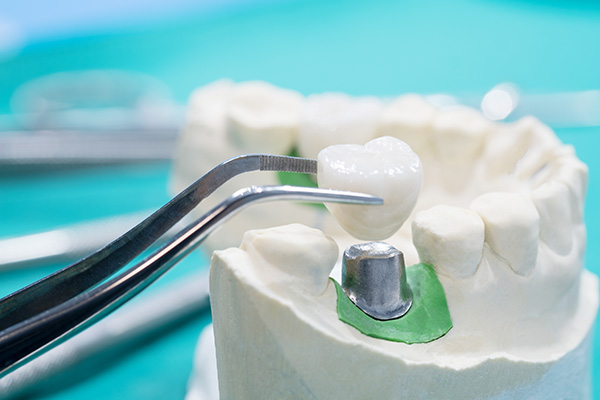General Dentistry Solutions Using Dental Crowns
 Dental crowns are one of the most commonly used restorations in general dentistry. These restorations provide restorative and cosmetic benefits to the tooth being covered with them. Some of the benefits of covering up a tooth with a dental crown include:
Dental crowns are one of the most commonly used restorations in general dentistry. These restorations provide restorative and cosmetic benefits to the tooth being covered with them. Some of the benefits of covering up a tooth with a dental crown include:
- The crown helps to keep what is left on the tooth intact, preventing it from breaking apart.
- The crown protects the tooth from bite forces.
- The crown restores the tooth’s function, allowing you to chew and bite foods with it.
- The crown protects the tooth from acids and bacteria in the mouth.
- The crown restores the appearance of the treated tooth.
How dental crowns are used in general dentistry
The process of getting a crown placed on a tooth typically requires two visits to a dentist. During the first appointment, the dentist prepares the tooth for the crown. This includes removing enamel from its sides to make a better fit for the crown. The patient is given a shot of a local anesthetic before shaving down the tooth so they do not feel pain.
However, removing a tooth’s enamel is a permanent alteration, and there is no way to reverse the process in the future. A tooth that has been prepared for a crown will always need one to protect it moving forward.
After shaving down the tooth’s enamel, the dentist asks the patient to bite down on a mold that leaves an impression of their tooth. The impression is sent to dental lab technicians who make restorations like crowns. It takes a couple of weeks for the crown to be made and sent back to the clinic.
The tooth gets a temporary crown to protect it from bacteria and acids in the mouth. The temp crown is held in place with temporary dental cement so the dentist can easily take it off when the patient’s custom crown is ready. The customized crown is cemented into place during the second visit to complete the treatment.
Crowns have many uses in general dentistry. Some of the problems a dentist might recommend a crown for include:
- Severe tooth decay or damage: A dentist might recommend a crown for a tooth that has been decayed or damaged to the point there is a good chance the tooth breaks apart. The crown holds the rest of the tooth together, and it prevents acids in the mouth and bite forces experienced while chewing from causing further damage. Depending on the extent of the damage, the dentist might perform a root canal before covering the tooth up with a crown.
- Discoloration: Some stains like those caused by tooth decay or taking tetracycline antibiotics cannot be removed with teeth whitening treatments. They are typically addressed by covering them up with restorations like crowns.
- Deformities: Crowns can be used to cover up poorly shaped or deformed teeth. The crown covers the tooth’s crown, hiding any flaws.
Get your crown
A dental crown can be the correct solution for damaged, discolored, or deformed teeth. Call or visit our Visalia clinic to set up an appointment with our dentist.
Request an appointment or call Visalia Care Dental at 559-975-1213 for an appointment in our Visalia office.
Related Posts
If you ask general dentistry professionals about improving oral wellness, they will tell you that it involves a lifetime of dental care. Having an aesthetically pleasing set of teeth is not enough; you need to cultivate good oral habits to keep them in good condition and prevent dental issues. This article provides tips for better…
General dentistry practitioners know that loose teeth in youngsters are common and cause little worry since the problem is with the "baby teeth." If you have a loose tooth or one of your children has a loose adult tooth, you may need to visit the general dentistry office to save it. Continue reading to discover…
Like a doctor’s office visit, general dentistry is not something you want to neglect or dismiss. Your oral health is as important as any other aspect of your well-being. As you go to the dentist’s office, you can find out about any troubling issues affecting your teeth and gums. In between dental appointments, you are…
